बैंगन के कीट पतंग तथा प्रबंधन कैसे करें।
Brinjal is one of the important solanaceous vegetable cultivated in arid region of Rajasthan. The crop is grown during the monsoon period where the supplement irrigation is available. In addition to abiotic stresses, the major challenge ahead brinjal cultivation is insect pests especially shoot and fruit borer, a devasting pest of brinjal In India. Often, farmers are going up to 10-30 spray per season to save the crop.
Over use of synthetic pesticides increase the cost of production at farmer level and increase the environmental and health hazards at consumer level. In this context, it is essential to step up towards IPM as it is more reliable and eco-friendly than any other methods. Here we have given some of IPM oriented strategies which will be highly useful to growers of this region to manage these pests successfully.
1. Shoot and fruit borer, Leucinodes orbonalis (Pyraustidae: Lepidoptera)
Most serious pest of brinjal and causes yield loss up to 60-70%.
Damage symptom
The infestation starts during early stage of the crop and continues throughout the fruiting stage. Initially the larvae attacks the shoots result in drooping of shoots and dead heart. Later stages, the larvae starts to feed on flower buds and fruits but it prefer more on fruits, the infestation during fruit set causes shedding of buds. Larvae bore the fruits and holes are sealed with excreta and make them unfit for consumption.
Biology of fruit borer in brinjal
The adult moths are white in colour with brownish red marking on the fore wing. And it lays an average of 250 eggs singly on the tender shoots, flowers and developing buds. Larvae are pinkish in colour and fully developed with prominent head capsule with sparse hairs on their body. Pest is active throughout the year but more during monsoon. The pupation takes place in the plant debris with brownish cocoon. The egg, larval and pupal period is 3-5, 15 and 7 days and it varies with season.
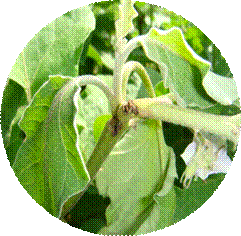

Shoot Borer damage on Brinjal Larvae inside of shoo
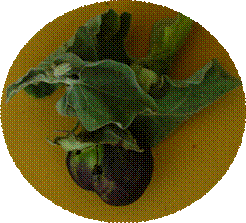
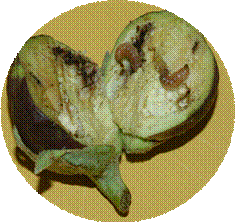
Damaged fruit Larvae inside the fruit
Management shoot borer in Brinjal
- Early removal of drooping shoots will reduce the fruit infestation.
- Proper collection of all the infested flower buds, fruits during harvest.
- Continuous cultivation of brinjal also favours the pest infestation.
- Varieties like Punjab Barsati, (moderate resistant cultivar) Pusa purple round, Punjab Neelam found to be resistant to brinjal fruit borer.
- Biological method recommended by IIHR, Bengaluru involving release of Trichogramma chilonis @10 to 15 lakh parasites/ha/season along with 2 sprays of Bt formulation found to be economically effective.
- Installation of BSFB pheromone traps to monitor and mass trap the male moths.
- Need based application of carbaryl 0.1% and profenofos 0.05% or spray of cypermethrin (0.0125%) at 2% flower buds damage threshold or at 15-20 days after flowering.
2. Hadda beetle, Henosepilachna vigintioctopuntata (Coccinellidae: Coleoptera)
It is one of the important pests of brinjal often it causes serious damage to leaf. Both grub and adult are causing the damage. It feeds the epidermal layer of leaves result in complete dry of leaves.
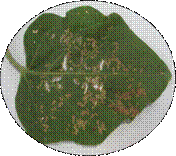
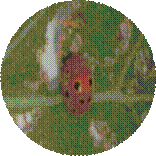
 Hadda beetle damage on Leaves Adult beetle Grub
Hadda beetle damage on Leaves Adult beetle Grub
Biology of Hadda Beetle
The adult beetle is brownish yellow with block colour spot (12-20) on the elytra and they are hemispherical in shape. Eggs are spindle or cigar shaped and bright yellow in colour and lay in clusters (10-20) on lower surface of the leaf in a group and grubs are spiny. Egg stage lasted in 3-4 days and grubs stage is 10-35 days. Pupation takes place within the leaf or stem and duration is 7 days. The total life cycle is about 17-50 days depending on the climate.
Management of Hadda beetle in Brinjal
- The separate management practices are not needed; the control measures taken for fruit borer are enough.
- Collection and destruction of grubs and adults at the early stage of infestation will reduce the further infestation
- Spray of contact insecticide like carbaryl (0.1%) or quinalphos (0.05%) when the incidence is severe.
- Need based application also will help to build up the larval-pupal Eulophid parasitoid Pediobius foveolatus which is found to be associated with this pest and cause significant mortality under natural condition.
3. Jassids, Empoasca devastans (Cicadellidae: Homoptera)
It is a ployphagous pest causing serious damage by sucking the leaf sap. The nymphs and adults suck the sap from under surface of the leaf and infested leaves curl upward in margins. While feeding it also inject the saliva and sever causes the leaves are crinkled with stunted growth. Brownish reddish colour at the leaf margin called as ‘hopper burn’ symptom.
Biology of Jassids
Adults are green colour slender insect and nymphs are different in colour with wedge shaped body. The younger leaves are more preferred for egg laying and they are laid singly inside of leaf veins on under side of the leaf. Activity of the pest can be observed throughout the season. The total life cycle is about 10-21 days.
Management of Jassids in Brinjal
- The varieties such as Kalyanpur, Punjab chamikila, GB-1, and GB-6 reported as resistant to Jassids, Aphids and Whitefly.
- Avoid over use of nitrogenous fertilizer and follow recommended spacing.
- Use yellow sticky traps to monitor the sucking pest activity.
- Application 5% dimethoate granule along seed furrows or spray of imidacloprid 25g a.i/ha will give better control.
Other important Sucking Pests
White fly, Bamisia tabaci and Aphid, Aphis gossypii also cause damages by sucking the sap from tender leaves leads to crinkling and yellowing of leaves. The infestation reduces the plant growth and vigour.
4. Root knot nematode, Meloidogyne incognita
The nematode damage is more detrimental to the seedling than the mature plant. The affected plant show stunted growth along with chlorotic symptom on the leaf and drastically affect the fruit setting. The numerous galls can be observed on the root of the plant when it is up rooted.
- Trap cropping marigold Tagetus sp are effective in controlling Melidogyne incognita.
- Crop rotation with non solaneceous crops.
- Treat the nursery beds with Carbofuran 2g a.i/m2 granules will give better control.
Authors
V. Karuppaiah1, S.K. Maheshwari1 and Hanif Khan2
1Central Institute for Arid Horticulture, Beechwal, Bikaner, Rajasthan-334006
2Regional Station, Directorate of Wheat Research, Flowerdale, Shimla (HP)
Email:
